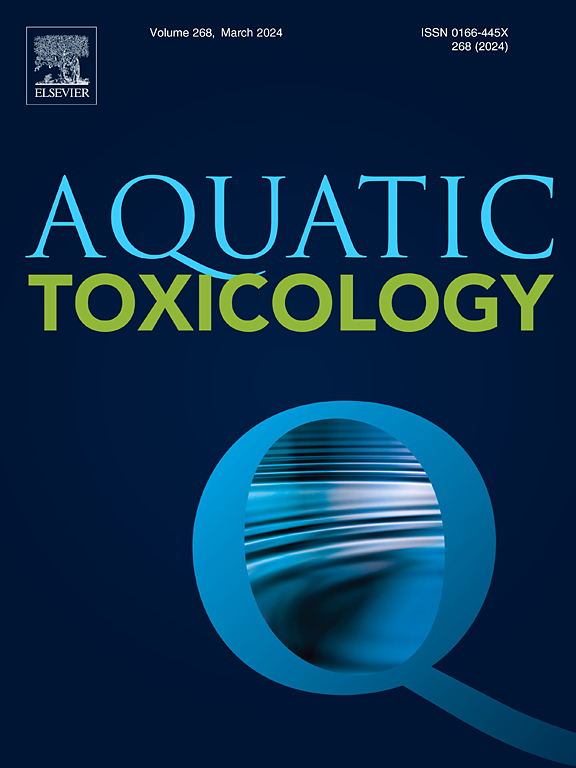Interactive effects of Titanium-based compounds with Gadolinium and Mercury in Mytilus galloprovincialis
IF 4.3
2区 环境科学与生态学
Q1 MARINE & FRESHWATER BIOLOGY
引用次数: 0
Abstract
The combined toxicity of metals in aquatic environments is a critical concern due to the complex interactions between different metal contaminants, as well as their interactions with other environmental factors. These combined effects often result in synergistic, antagonistic, or additive toxic responses, leading to heightened risks for aquatic organisms and ecosystems. This study investigates the toxicity of titanium in its bulk form (Ti) and as nanoparticles (nTi) when combined with other elements like gadolinium (Gd) and mercury (Hg), focusing on their effects on the mussel Mytilus galloprovincialis. Mussels were exposed to Ti or nTi alone, or their combination with Gd or Hg. Biomarkers of metabolic capacity and oxidative stress were measured to assess the impacts on the organisms. The results showed that exposure to Ti and nTi alone did not significantly disrupt the mussels' metabolic capacity, energy reserves or antioxidant defense systems, indicating that these concentrations were below the toxicity threshold. However, when mussels were exposed to Gd and Hg, in combination with Ti or nTi, the metabolism increased, the detoxification enzyme rose, the redox homeostasis was disrupted, leading to cellular damage. The integrated biomarker index showed that mussels were more responsive to the combination of Ti/nTi+Hg, highlighting the elevated toxicity of co-exposure to Ti and Hg. These findings suggest that while Ti-based materials may not pose significant oxidative stress on their own, their interaction with more toxic elements like Gd and Hg exacerbates the organisms' metabolic burden, compromising their health. This study emphasizes the importance of considering pollutant mixtures in assessing the environmental impacts of emerging and traditional contaminants.

钛基化合物在褐贻贝中与钆、汞的交互作用
由于不同金属污染物之间复杂的相互作用,以及它们与其他环境因素的相互作用,金属在水生环境中的综合毒性是一个重要的问题。这些综合影响往往导致协同、拮抗或加性毒性反应,导致水生生物和生态系统的风险增加。本研究调查了大块钛(Ti)和纳米钛(nTi)与钆(Gd)和汞(Hg)等其他元素结合时的毒性,重点研究了它们对贻贝(Mytilus galloprovincialis)的影响。贻贝单独暴露于Ti或nTi,或与Gd或Hg联合暴露。测量代谢能力和氧化应激的生物标志物,以评估对生物体的影响。结果表明,单独暴露于Ti和nTi并没有显著破坏贻贝的代谢能力、能量储备或抗氧化防御系统,表明这些浓度低于毒性阈值。然而,当Gd和Hg与Ti或nTi共同作用时,贻贝代谢增加,解毒酶升高,氧化还原稳态被破坏,导致细胞损伤。综合生物标志物指数显示,贻贝对Ti/nTi+Hg的组合反应更敏感,突出了共同暴露于Ti和Hg的毒性升高。这些发现表明,尽管Ti基材料本身可能不会造成显著的氧化应激,但它们与Gd和Hg等毒性更大的元素的相互作用会加剧生物体的代谢负担,损害它们的健康。本研究强调了在评估新兴污染物和传统污染物的环境影响时考虑污染物混合物的重要性。
本文章由计算机程序翻译,如有差异,请以英文原文为准。
求助全文
约1分钟内获得全文
求助全文
来源期刊

Aquatic Toxicology
环境科学-毒理学
CiteScore
7.10
自引率
4.40%
发文量
250
审稿时长
56 days
期刊介绍:
Aquatic Toxicology publishes significant contributions that increase the understanding of the impact of harmful substances (including natural and synthetic chemicals) on aquatic organisms and ecosystems.
Aquatic Toxicology considers both laboratory and field studies with a focus on marine/ freshwater environments. We strive to attract high quality original scientific papers, critical reviews and expert opinion papers in the following areas: Effects of harmful substances on molecular, cellular, sub-organismal, organismal, population, community, and ecosystem level; Toxic Mechanisms; Genetic disturbances, transgenerational effects, behavioral and adaptive responses; Impacts of harmful substances on structure, function of and services provided by aquatic ecosystems; Mixture toxicity assessment; Statistical approaches to predict exposure to and hazards of contaminants
The journal also considers manuscripts in other areas, such as the development of innovative concepts, approaches, and methodologies, which promote the wider application of toxicological datasets to the protection of aquatic environments and inform ecological risk assessments and decision making by relevant authorities.
 求助内容:
求助内容: 应助结果提醒方式:
应助结果提醒方式:


